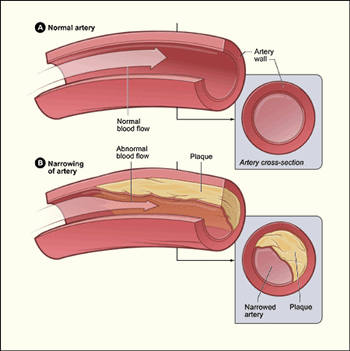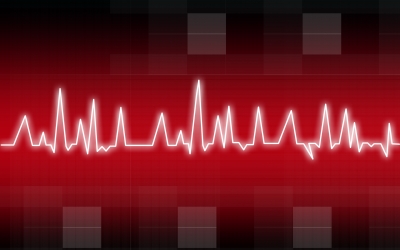![]() Atherosclerosis Risks
Atherosclerosis Risks
![]() Signs-Symptoms
Signs-Symptoms
![]() Atherosclerosis Prevention
Atherosclerosis Prevention
![]() Atherosclerosis Treatment
Atherosclerosis Treatment
![]() Atherosclerosis Key Points
Atherosclerosis Key Points
![]()
Heart Disease Symptoms website
Exactly What Is Atherosclerosis Heart Disease? and its Causes and Treatment Options?
 Figure A shows a normal artery with normal blood flow. Figure B shows an artery wall with plaque buildup.
Figure A shows a normal artery with normal blood flow. Figure B shows an artery wall with plaque buildup.
A good date to look at atherosclerosis heart disease and its symptoms is today , and discover ways to help hearts with healthy eating and regular exercise, such as swimming or water walking
Atherosclerosis (ath-er-o-skler-O-sis) is a disease in which plaque (pronounced plak) tends to build-up inside your arteries. Arteries are blood vessels that carry oxygen-rich blood to your heart and other areas of your body.
Plaque is made up of fat, cholesterol, calcium, and other substances found in the blood. Over time, plaque hardens and narrows your arteries, limiting the flow of oxygen-rich blood to your organs and other parts of your body. This can lead to serious problems, including stroke, or even death.
Atherosclerosis-Related Diseases
Atherosclerosis can affect any artery in the body, including arteries in the heart, brain, arms, legs, and pelvis. As a result, different diseases may develop based on which arteries are affected.
Coronary Heart Disease
Coronary heart disease (CHD) occurs if plaque builds up in the coronary arteries. These arteries supply oxygen-rich blood to your heart.
Plaque narrows the coronary arteries and reduces blood flow to your heart muscle. It also makes it more likely that blood clots will form in your arteries. Blood clots can partially or completely block blood flow.
When blood flow to your heart muscle is reduced or blocked, it can lead to angina (chest pain) and a heart attack. CHD also is called coronary artery disease or heart disease. It's the leading cause of death for both men and women in the United States.
Plaque also can form in the heart's smallest arteries. When this happens, it's called coronary micro vascular disease (MVD). In coronary MVD, plaque doesn't always cause blockages in the arteries as it does in CHD.
Carotid Artery Disease
Carotid (ka-ROT-id) artery disease occurs if plaque builds up in the arteries on each side of your neck. These arteries supply oxygen-rich blood to your brain. When blood flow to your brain is reduced or blocked, it can lead to a stroke.
Peripheral Arterial Disease
Peripheral arterial disease (P.A.D.) occurs if plaque builds up in the major arteries that supply oxygen-rich blood to your legs, arms, and pelvis.
When blood flow to these parts of your body is reduced or blocked, it can lead to numbness, pain, and possibly lead to infections.
The cause of atherosclerosis isn't known. However, certain traits, conditions, or habits may raise your risk for the disease. These conditions are known as risk factors.
You can control some risk factors, such as lack of physical activity, smoking, and an unhealthy diet. Others you can't control, such as age and a family history of heart disease.
Some people who have atherosclerosis have no signs or symptoms. They may not be diagnosed until after a heart attack or stroke.
The main treatment for atherosclerosis is lifestyle changes. You also may need medicines and medical procedures. These treatments, along with ongoing medical care, can help you live a healthier life. Click-here for Health Tip-of-the-Day.
Outlook for Atherosclerosis Heart Disease
 Better treatments have reduced the number of deaths from atherosclerosis-related diseases. These treatments also have improved the quality of life for people who have these diseases. However, atherosclerosis remains a common health problem.
Better treatments have reduced the number of deaths from atherosclerosis-related diseases. These treatments also have improved the quality of life for people who have these diseases. However, atherosclerosis remains a common health problem.
You may be able to prevent or delay atherosclerosis and the diseases it can cause. Making lifestyle changes and getting ongoing care can help you avoid the problems of atherosclerosis and live a long, healthy life.
Other Names for Atherosclerosis
- Arteriosclerosis
- Hardening of the arteries
What Causes Atherosclerosis?
The exact cause of atherosclerosis isn't known. However, studies show that atherosclerosis is a slow, complex disease that may start in childhood. It develops faster as you age.
Atherosclerosis may start when certain factors damage the inner layers of the arteries. These factors include:
- Smoking
- High amounts of certain fats and cholesterol in the blood
- High blood pressure
- High amounts of sugar in the blood due to insulin resistance or diabetes
When damage occurs, your body starts a healing process. The healing may cause plaque to build up where the arteries are damaged.
Eventually, a section of plaque can break open, causing a blood clot to form at the site. A blood clot will narrow the artery even more and may worsen angina (chest pain) or cause a heart attack or stroke.
Researchers continue to look for the causes of atherosclerosis. They hope to find answers to questions such as:
- Why and how do the arteries become damaged?
- How does plaque develop and change over time?
- Why does plaque crack and lead to blood clots?
Websites of Interest
![]() Visit Healthy Lifestyles Program Health & Wellness web site...
Visit Healthy Lifestyles Program Health & Wellness web site...




